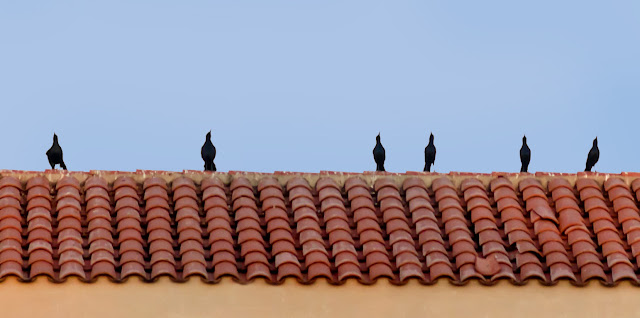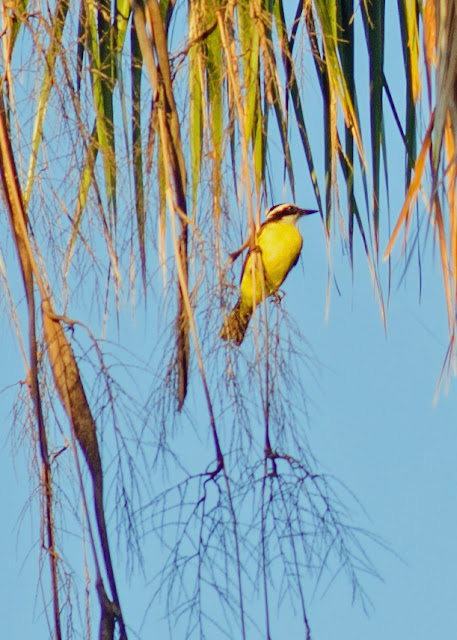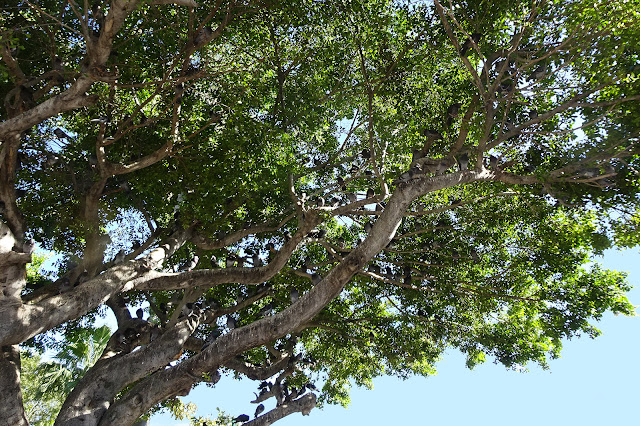Wherever we went in Mazatlan, there were birds. Lifers, as often as not. Sometimes I managed to take photos with whatever camera was on hand; sometimes, laden down with purchases, big floppy hat that kept blowing off, maps and sunglasses (on again, off again, depending on the shade I kept hiding in), by the time I'd scrabbled through my bags and dug out the camera, either the birds or my vehicle of the moment had moved on. The trials of a tourist!
And sometimes, even when I was prepared and had the time, I only heard the birds and couldn't see them. Picture an oldish lady in a wide-rimmed, black hat, roasting in blazing sunlight on a cobblestone street. See her, camera ready, staring up into a tree, dodging the occasional car, returning again to stare into the branches. And then, reluctantly, turning off the camera and trudging on. Picture the bemused or amused glances of residents passing by. Tourists!
Some birds I recognized, even with brief glances; violet-green swallows, sparrows, a goldfinch, common rock pigeons, the great-tailed grackle (like our crow, in behaviour and colour, but longer and bluer.) Some looked familiar at first glance, but then were subtly different from those I'm used to.
There was another bird hanging around the edge of the rocks with me while I watched surfbirds, a pale brown, almost featurless peep. The camera refused to focus, choosing rather the darker rocks right behind it. I think, from memory, that it was probably a
willet.
 |
| House sparrows. Although, if the back one is a female, her beak should be yellowish. |
 |
| When the light hits them just right, they shine in iridescent blues and purples. |
 |
| Male grackles on a roof ridge, displaying for the females. Lots of competition here! |
Territorial “ruff-out” displays of erected feathers, fanned tail, and bill held skyward may erupt into wrestling matches, with competing males locking talons and rolling on the ground. (Cornell)
This was another lifer: the boat-billed flycatcher.
 |
| Boat-billed flycatcher, Megarynchus pitangua, with nest. A shy bird; one camera click, and she ducked down out of sight. |
 |
| The back and tail are brown. There is a yellow patch on top of the head, only visible at certain angles. |
The
great Kiskadee is an almost identical bird, also present in the area. But it has a reputation for being bold and noisy; these ones were wary of humans and quick to hide, so I think they're b-b flycatchers. As always, I could be wrong.
Another shy bird.
 |
Some sort of woodpecker*. Photo lightened up considerably; she was hiding in deep shade. For the next photo, she ducked behind the branch and only showed the top of her head.
*Update: Gila Woodpecker Melanerpes uropygialis |
And of course, there are always common city pigeons.
 |
| One on the beach |
 |
| Hundreds in a tree. Zocalo, Antigua Mazatlan. |
I want to go back.











Interesting how the most familiar animals in our vicinity would be also be deemed exotics to our tourists! How did your critter tank keep while you were away?
ReplyDeleteYes, I remember when family from Toluca, Mexico came to visit, and how astounded they were at our crows!
ReplyDeleteI was worried about the tank, but did my best; cleaned it out and changed the water and filter the night before I left, reduced the hours of the light on a timer, opened a window, and turned off the heat. I figured that since we were still in March, the weather might be cool enough for them to make it.
And they were fine. One clam got eaten, but all the crabs and hermits turned up. The anemones were sulking. I changed the water first thing when I got in, and fed the scavengers, and they all perked up. By the next morning, the anemones had decided to wake up again.
I wouldn't try that later in the year, when it's warmer; I'd have someone come in and replace ice in the tank, at least.
For your woodpecker, consider Gila Woodpecker Melanerpes uropygialis
ReplyDeleteUpupaepops; thanks! That matches. This one would be a female, since she has an unmarked head.
ReplyDelete